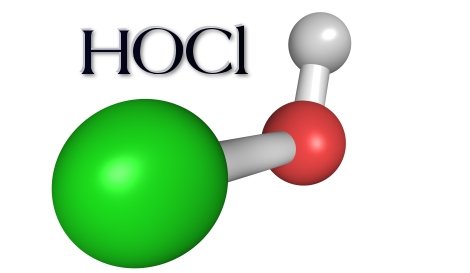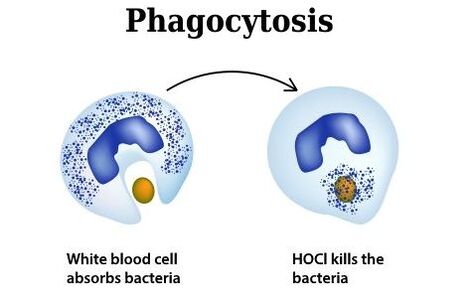

1. Hypochlorous acid is a free chlorine molecule with the chemical structure HOCl. It is the dominate free chlorine species in chlorine solutions that have a slightly acidic to neutral pH. HOCl is a much more powerful oxidant than sodium hypochlorite (or chlorine bleach).
2. Hypochlorous acid is produced naturally by the white blood cells of all mammals. It is used by white blood cells to kill invading microbial pathogens
3. Hypochlorous acid (HOCl) is a neutrally charged molecule. Bacteria have negatively charged cell walls. Just like magnets, molecules with the same charge will repel each other. For example, the negatively charged molecule of bleach (OCl-) is repelled by bacterial cell walls. This is not the case with HOCl which is neutrally charged. HOCl easily penetrates bacterial cell walls. HOCl either oxidizes the cell walls killing the bacteria or enters through the cell walls and destroys the vital components inside the bacteria.


4. Chlorine is an extremely effective disinfectant for inactivating bacteria. A study conducted during the 1940s investigated the inactivation levels as a function of time for E. coli, Pseudomonas aeruginosa, Salmonella typhi, and Shigella dysenteriae (Butterfield et al., 1943). Study results indicated that HOCl is more effective than OCl- (aka. chlorine bleach) for inactivation of these bacteria. These results have been confirmed by several researchers that concluded that HOCl is 70 to 80 times more effective than OCl- for inactivating bacteria (Culp/Wesner/Culp, 1986). Since 1986, there have been hundreds of publications confirming the superiority of HOCl over OCl- (click here to visit research database). HOCl may be more effective than OCl- for two reasons, this first is because it holds a neutral charge and therefore can easily penetrate the negatively charged cell walls of bacteria. The second reason is because HOCl has a much higher oxidation potential than OCl-.
5. Hypochlorous is a powerful oxidant and is 100 times more efficient at killing microbial pathogens than sodium hypochlorite (aka. chlorine bleach).
What Breathing Does for the Body - How the Lungs Work - What Breathing Does for the Body
Breathing involves two phases: breathing in and breathing out. Your lungs deliver oxygen and remove carbon dioxide from your blood in a process called gas exchange. Gas exchange happens in the capillaries surrounding the alveoli, where the oxygen that is breathed in enters the circulatory system and carbon dioxide in the blood is released to the lungs and then breathed out. If you have problems breathing, gas exchange may be impaired, increasing the risk of serious health problems.
Breathing in
- How the Lungs Work - What Breathing Does for the Body
When you breathe in, or inhale, your diaphragm contracts and moves downward. This increases the space in your chest cavity, and your lungs expand into it. The muscles between your ribs also help enlarge the chest cavity. They contract to pull your rib cage both upward and outward when you inhale.
As your lungs expand, air is sucked in through your nose or mouth. The air travels down your windpipe and into your lungs. After passing through your bronchial tubes, the air travels to the alveoli, or air sacs.
Gas exchange
Gas exchange in your lungs. When you breathe in, air enters your nose or mouth, and passes into your windpipe, also called the trachea. At the bottom, the windpipe divides into two bronchial tubes, then branches into smaller bronchioles. The brochioles end in tiny air sacs, called alveoli. Here the oxygen you inhaledi passes into the bloodstream, and carbon dioxide from your body passes out of the bloodstream. The carbon dioxide is expelled from your body when you exhale. Medical Animation Copyright © 2019 Nucleus Medical Media Inc. All rights reserved.
Through the very thin walls of the alveoli, oxygen from the air passes into your blood in the surrounding capillaries. At the same time, carbon dioxide moves from the capillaries into the air sacs. This process of exchanging oxygen for carbon dioxide is called gas exchange. The oxygen in your blood is stored inside your red blood cells by a protein called hemoglobin.
The oxygen-rich blood from the lungs is carried to the left side of the heart through the pulmonary veins. The left side of the heart pumps the blood to the rest of the body. There, the oxygen in the red blood cells moves from blood vessels into surrounding tissues.
As carbon dioxide is released from the cells of the body, it travels in the bloodstream to the heart. The blood rich in carbon dioxide is then pumped from the right side of the heart through the pulmonary artery to the lungs, where gas exchange occurs.
For more information on blood flow, visit our How the Heart Works Health Topic.
Breathing out
- How the Lungs Work - What Breathing Does for the Body
When you breathe out, or exhale, your diaphragm and rib muscles relax,reducing the space in the chest cavity. As the chest cavity gets smaller, your lungs deflate, similar to the releasing of air from a balloon. At the same time, carbon dioxide-rich air flows out of your lungs through the windpipe and then out of your nose or mouth.
Breathing out requires no effort from your body unless you have a lung disease or are doing physical activity. When you are physically active, your abdominal muscles contract and push your diaphragm against your lungs even more than usual. This rapidly pushes air out of your lungs.
Conditions that affect the respiratory system
- How the Lungs Work - What Breathing Does for the Body
Damage, infection, or inflammation in the lungs or airways or both can lead to the following conditions.
Exposure to cigarette smoke, air pollutants, or other substances can damage the airways, causing disease of the airways or making a disease more severe.
Syndicated Content Details:
Source URL: https://www.nhlbi.nih.gov/subscribe/4461
Source Agency: National Heart, Lung, and Blood Institute (NHLBI)
Captured Date: 2019-09-24 16:43:00.0
How Your Body Controls Breathing - How the Lungs Work - How Your Body Controls Breathing
The body’s muscles and nervous system help control your breathing.
The pleura and diaphragm. Your lungs are encased by pleura, a thin membrane that protects them and helps them slide back and forth as you breathe in and out. Underneath your lungs is the diaphragm, a smooth thin muscle that helps your lungs expand and contract as you breathe. Medical Animation Copyright © 2019 Nucleus Medical Media Inc. All rights reserved.
The pleura and the muscles used for breathing
- How the Lungs Work - How Your Body Controls Breathing
The lungs are enclosed by the pleura, a membrane that has two layers. The space between these two layers is called the pleural cavity. The membrane’s cells create pleural fluid, which acts as a lubricant to reduce friction during breathing.
The lungs are like sponges; they cannot move on their own. Muscles in your chest and abdomen contract, or tighten, to create space in your lungs for air to flow in. The muscles then relax, causing the space in the chest to get smaller and squeeze the air back out.
These muscles include the:
Damage to the nerves in the upper spinal cord can interfere with the movement of your diaphragm and other muscles in your chest, neck, and abdomen. This can happen due to a spinal cord injury, a stroke, or a degenerative disease such as muscular dystrophy. The damage can cause respiratory failure. Ventilator support or oxygen therapy may be necessary to maintain oxygen levels in the body and protect the organs from damage.
Role of the nervous system
- How the Lungs Work - How Your Body Controls Breathing
Your breathing usually does not require any thought, because it is controlled by the autonomic nervous system, also called the involuntary nervous system. The autonomic nervous system has different effects on your breathing.
Your breathing changes depending on how active you are and the condition of the air around you. For example, you need to breathe more often when you do physical activity. In contrast, your body needs to restrict how much air you breathe if the air contains irritants or toxins. At times, you can control your breathing pattern, such as when you hold your breath or sing.
To help adjust your breathing to changing needs, your body has sensors that help your respiratory system provide enough oxygen to the body while removing carbon dioxide. The sensors transmit signals to the centers of the brain involved in breathing. These sensors include:
Some health conditions can interfere with brain signals to the airways and chest muscles, causing central sleep apnea. In central sleep apnea, the respiratory centers of the brain do not respond properly to rising carbon dioxide levels and do not properly control the diaphragm and intercostal muscles. As a result, breathing stops for a short period. Central sleep apnea can lead to stroke and other medical conditions.
Look for
- How the Lungs Work - How Your Body Controls Breathing
Syndicated Content Details:
Source URL: https://www.nhlbi.nih.gov/subscribe/4462
Source Agency: National Heart, Lung, and Blood Institute (NHLBI)
Captured Date: 2019-09-24 16:43:00.0
Keeping Your Lungs Healthy - How the Lungs Work - Keeping Your Lungs Healthy
You can take steps to help protect your lungs from injury or disease, including:
How do your lungs change as you get older?
Read moreAs you age, the lung tissue that helps keep your airways open can lose elasticity, which means they cannot expand or contract as easily as when you were younger. The muscles your body uses for breathing may get smaller or weaker and your spine can curve more, leaving less space for your lungs to expand. It can take longer to clear mucus and particles from your airways. It can also become harder to cough. These changes can make it harder to breathe during physical activity as you get older.
Read less
Look for
- How the Lungs Work - Keeping Your Lungs Healthy
Syndicated Content Details:
Source URL: https://www.nhlbi.nih.gov/subscribe/4464
Source Agency: National Heart, Lung, and Blood Institute (NHLBI)
Captured Date: 2019-09-24 16:43:00.0